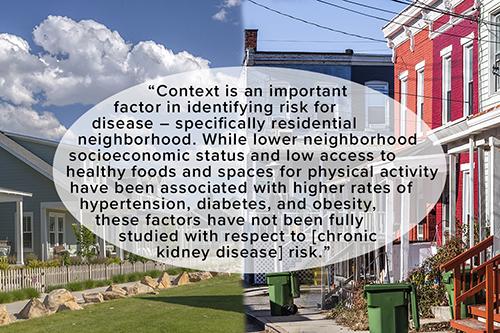October 18, 2019
Hicken and colleagues examine neighborhood social context and kidney function in a multi-ethnic study
 SRC researcher Margaret T. Hicken and collaborators recently published an analysis using Cox proportional hazards and linear mixed regression models to investigate residential neighborhood context and its relationship to chronic kidney disease (CKD), over time. The group published their findings in the American Journal of Kidney Diseases – the official journal of the National Kidney Foundation. Within five months of the publication of the article, news outlets have mentioned the article five times and social media has mentioned the article over three dozen times.
SRC researcher Margaret T. Hicken and collaborators recently published an analysis using Cox proportional hazards and linear mixed regression models to investigate residential neighborhood context and its relationship to chronic kidney disease (CKD), over time. The group published their findings in the American Journal of Kidney Diseases – the official journal of the National Kidney Foundation. Within five months of the publication of the article, news outlets have mentioned the article five times and social media has mentioned the article over three dozen times.
Context is an important factor in identifying risk for disease – specifically residential neighborhood. While lower neighborhood socioeconomic status and low access to healthy foods and spaces for physical activity have been associated with higher rates of hypertension, diabetes, and obesity, these factors have not been fully studied with respect to CKD risk. Furthermore, there are known disparities across race/ethnicity in prevalence of CKD and distribution of neighborhood contexts, with blacks experiencing higher levels of CKD, more neighborhood problems and worse neighborhood cohesion. Being able to identify features of the neighborhood beyond socioeconomic factors could help public health practitioners and clinicians identify important sources of stress and resilience may influence CKD-related health behaviors and thus help reduce these disparities.
These researchers capture aspects of residential neighborhood by creating scores based on participant-reported aspect of their neighborhoods at study entry for neighborhood problems (adequacy of food sources, availability of parks/playgrounds, noise, sidewalks, traffic, trash and litter, and violence) and social cohesion (attributes of people in their neighborhood including close knit, get along, willing to help neighbors, trustworthy, share values). They also examine kidney function in terms of an estimated glomerular filtration rate (eGFR; creatinine-cystatin C equation) and an indicator of eGFR decline (>30% across ten years and four exams).
The authors used baseline characteristics of participants in the Multi-Ethnic Study of Atherosclerosis (MESA) across quartiles of neighborhood problems and social cohesions scores. Next, they examined unadjusted cross-sectional associations between the neighborhood dimensions and eGFR at baseline. To examine the relationship between neighborhood dimensions and eGFR decline over time, they used linear mixed models with random intercepts, accounting for the correlation within participants. In addition to their unadjusted model, they build a second set of epidemiological models by including individual-level sociodemographic factors and MESA study site as confounders and then a third model including potential mediators that may link neighborhood context to eGFR decline in a fully specified model.
The authors report no association between the neighborhood scores and eGFR in the baseline models within any of the race/ethnic groups. In the longitudinal analyses, the hazard of an eGFR decline >30% from baseline was not statistically different for those in the highest quartile of neighborhood problems to the lowest quartile, though the decline in eGFR for those with greater neighborhood problems was greater than for those in the lowest quartile of problems.
At the conclusion, the authors state their null findings may be interpreted in several ways. It is possible that perceived social environment does not play an important role in very early stages of CKD. Null findings could have been a result of measurement error, as neighborhood social context is difficult to measure without error. Social context may be interrelated with neighborhood sociodemographic characteristics and disentangling the two may be difficult. They also note that individual-level factors (e.g. individual-level SES) may be important with eGFR decline in a healthy cohort – though literature on this topic is unclear.
Despite the null findings of this study, neighborhood SES has been a consistently associated with known risk factors for CKD including incident hypertension, cardiovascular disease, diabetes, and smoking prevalence, inflammatory markers, depressive symptoms, and alcohol use. With the large disparities in CKD and in neighborhood context between blacks and whites, combined with the null findings in these race/ethnic groups between CKD and neighborhood context, the authors suggest that future work should examine the role of racial residential segregation.
In order to uncover the origins of these pronounced health disparities (e.g. CKD); we need to have a clear picture of what is, and what is not. I feel it is extremely important to publish these null findings, and appreciate that the authors, and the journal, have taken the time to carefully lay out their analysis and publish the results – even as null results.
Hicken, Margaret T., Ronit Katz, Carmen A. Peralta, Deidra C. Crews, and Holly J. Kramer. 2019. 'Neighborhood Social Context and Kidney Function Over Time: The Multi-Ethnic Study of Atherosclerosis' American Journal of Kidney Diseases 73 (5): 585-95.